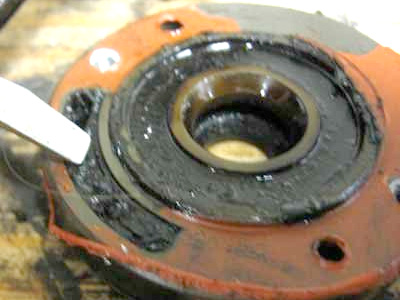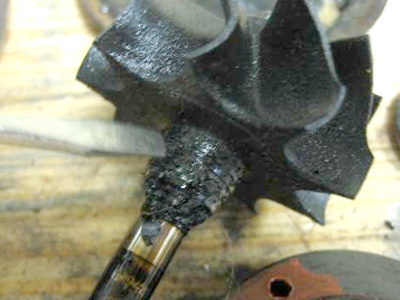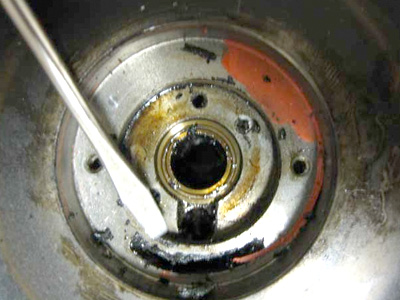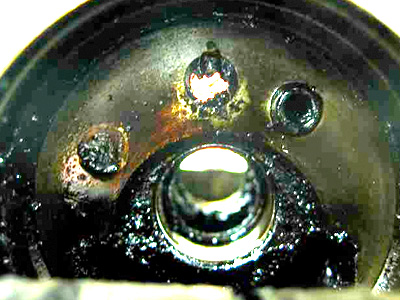
Common Causes Of Turbocharger Failure
• Improper Lubrication/Lack Of Maintenance
• Foreign Object Damage
• Overspeeding
Please read through this section thoroughly, this contains extremely important information to prolong the life of your turbo! Be sure to check out Turbocharger Maintenance in our Knowledge Base menu in the upper navigation bar
What Causes Failure And How To Maintain My Turbo
The number one cause of most turbocharger failure can be traced back to the engines lubrication system. The turbochargers bearings depend on a constant flow of clean oil to function properly. Several factors can lead to the break down of the oiling system, lack of maintenance, improper oil or filter, severe driving conditions, or in most cases simply the age of the vehicle can contribute to degradation of the turbochargers supply of oil.
The bearings in 90% of all production turbochargers are a full floating bronze bushing which supports the turbochargers rotating group. The clearances between the bearings and housing are very tight so any contaminants held within the oil can do damage very quickly if not corrected. The best defense you have against oil borne contaminates is a very strict maintenance schedule. Often the OE manufacturers recommended interval between oil changes will not be sufficient. I recommend changing your oil and filter any time the oil starts to change from its original golden brown to a darker brown color. In some higher mileage cars this could happen within 2000 miles or even sooner. The reason the oil is changing color is due to a few key reasons. First, most of today’s oils are very high in detergent, this is designed to keep engines cleaner longer. Unfortunate for the turbocharger, these detergents deposit a large amount of engine “dirt” into the oiling system. If left unchanged for 3500 or more miles the oil becomes saturated with this accumulated dirt and starts to become very abrasive to the fine clearances inside of the turbocharger. Strict scheduling and maintaining regular oil and filter changes is critical to the life of the turbo.
The following are examples of carbon buildup due to infrequent oil changes or improper oil type:




The following are examples of oil contamination:
The other key factor is engine heat. Today’s newer engines run very high water and oil temperatures to help with emissions and fuel economy. This heat is very hard on the oil, causing it to break down on a molecular level resulting in having a reduced ability to provide lubrication and viscosity. The increased heat is also compounded when you shut down your engine and the car is allowed to heat soak. Along with frequent oil changes it is also advisable to allow the car about one to one and a half minutes of idle time before the engine is turned off if you have been driving at higher speeds, for example on the interstate.
The following are examples of heat failure:
Another common cause of turbocharger damage is from foreign objects entering either the compressor inlet from the air filter system, or through the turbine inlet coming out of the engines combustion chamber. Anytime you service your air filter, be sure to thoroughly inspect all of the system for loose connections or any small amounts of dirt, leaves or other debris that might accidentally enter the air filter housing. The compressor wheel in every turbocharger is very delicate, and any trash left inside the housing will be immediately detrimental to the turbochargers operation. On the turbine side of the turbocharger the only user serviceable items that could be potentially harmful will be the spark plugs and possibly any pre turbocharger oxygen sensors. Replace these only with the specified parts listed as replacements by the OE manufacturer. Running the incorrect spark plugs could result in detonation or resignation of the combustion event that will cause overheating of the combustion chamber and possible damage to the engine and turbocharger.
The following are examples of foreign object damage:
Over-speeding is a cause of turbocharger failure that is fairly difficult to diagnose. The compressor speed, or boost pressure, is determined in most cases by a waste gate actuator that simply regulates the speed of the turbine by allowing exhaust to bypass the turbine wheel once a desired manifold pressure is achieved. If there is a leak between the compressor and the engine, proper pressure will be harder for the turbocharger to obtain; the waste gate will remain in the closed position until the turbocharger overcomes the leak and provides pressure within the intake manifold. Even a small leak can cause the turbo to work 20% harder than normal to reach its desired pressure, so great care should be given to the plumbing system on the pressure side of the turbocharger. Inspect all hoses and fittings for fitment and tightness, looking closely for piping that could rub and wear holes that could cause leaks. Also inspect the intercooler core and compressor, bypass valve, if equipped for proper function.
The exhaust system after the turbocharger needs regular inspection. Increased back pressure due to clogged or damaged catalytic converters, resonators or mufflers will decrease the flow out of the engine and also raise the temperature inside the turbochargers exhaust housing, which contributes to the oil coking and also raises the risk of gasket failures or cracks in the exhaust manifold and turbine housing area. Usually this only occurs in older cars, or with higher mileage cars. 10 years or 100,000 miles is an average life span of most modern exhaust systems.
How Do I Know If My Turbocharger Is In Need Of Service?
If you have noticed a drop off in the performance or economy of your turbocharged car, and suspect the turbo might be the problem, there are several ways to inspect your system for proper operation. Assuming that the air filter, exhaust system and fuel system are in good operating condition, you can focus directly on the turbocharger itself. You will need to remove the air filter system to gain access to the front of the turbocharger, making notes on any amounts of oil or loose connections you might find. Once you can visually see the compressor wheel, look for the following signs: You should find a clean, oil-free wheel, without any signs of nicks, dings, or evidence of rubbing between the wheel and the compressor housing. Making sure the turbo is cool enough to touch, check to see if the turbocharger rotates freely, with minimal amounts of up and down movement. The wheel will have some movement in the bearings in a radial motion, but there should never be enough play to allow the wheel to contact the housing. Next, you will want to push and pull on the compressor shaft feeling for axial movement. There should never be any movement that you can feel in this direction; the nominal clearance is usually less than .0035”. You can use a dial indicator to verify, if you have access to that equipment. If it passes inspection on the compressor side, it is time to move over to the exhaust side. You will have to remove the exhaust pipe all the way at the turbocharger, and be able to see the turbine wheel. The wheel should be fairly clean, without any signs of wetness from oil, large amounts of carbon build up, etc. The wheel should be very dry to the touch, without any scale or other contaminants built up on its surface. There should be no signs of rubbing or damage to the blades. The turbine wheel shaft directly connects it to the compressor wheel, so spinning one should also spin the other. While you are looking at the exhaust side of the turbo, inspect the housing for any signs of cracks or leaks, any of which can cause a lack in performance. The usual signs of a turbo that is failing will be the accumulation of oil on one or the other housings, excessive bearing movement or wheel to housing contact.
What Determines If A Turbocharger Is Able To Be Rebuilt?
When WORK Turbochargers quote you a price for your turbocharger rebuild, it will be based on the following criteria. The turbo must be in a condition that allows for a successful rebuild to OE specifications, this means that the turbo housings must be free from cracks. The compressor and turbine wheels must be in a re-useable condition, as must the bearing housing. Sometimes it is necessary to machine the turbine wheel shaft as well as bearing housing bore to provide a new surface for the bearings to ride. This is usually considered standard on a rebuild. If not I will specify the additional charges that might be associated with this service.
If the major parts of the turbocharger are in rebuildable condition, the work will be performed for the price quoted. If the turbocharger has items that are non-rebuildable the price will be plus these additional items. In most cases I will have replacement options as well as new options available for most turbo models. Multiple options will help you save money and also contribute to the “Going Green” philosophy of the rebuilding process.
What Does A Turbocharger Rebuild Consist Of?
Once your turbocharger arrives, it will be visually inspected and a full inventory record will be made to ensure all of the turbocharger and other fittings, brackets etc. will be returned to you. The turbocharger is then disassembled and inspected, you will then be contacted with the condition of the turbocharger as well as a preliminary estimate. Once we receive your approval to continue the service, the turbocharger component pieces will be fully cleaned and all critical measurements will be taken, and any machine work will be preformed. At that time all of the rotating parts of the turbo will be balanced dynamically and all of the new bearings, seals, o-rings will be prepped for assembly. The end housings will be sand blasted and coated to prevent corrosion where needed, the waste gate actuator will be tested and finally everything will be assembled in a clean room environment to guarantee the highest quality service we can provide. Your inspection fee is applied to the service of the rebuild.
What Is Involved When I Install My New Or Rebuilt Turbocharger?
Aside from the actual act of removing and re-installing your turbocharger, there are a few things that will need some extra attention. Since most turbocharger failures result from oil issues, we require that the entire oil feed line system be replaced with new parts at the time of turbo replacement. If left uncorrected, oil coking, or carbon build up within the oil line passages create blockage and also a contamination issue. Changing these lines and fittings will ensure that the highest quality of oil is delivered to the new turbocharger. Your oil and filter will also need to be replaced, again to ensure quality clean oil to the new turbo.
Other items you will need to have available will be any gaskets for the exhaust manifold to turbine housing, turbine housing to down pipe, oil return line flange, any water line copper crush washers as well as any rubber coolant lines that might be in the proximity of the turbocharger. Not all turbos will have these gaskets, so be sure to ask us what you might need to complete your job.
